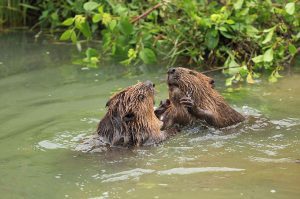
EBKXT9 Eurasian beaver, European beaver (Castor fiber), two beavers tussling in the water, Germany, Baden-Wuerrtemberg
A map of trees supplied by aerial mapping company Bluesky is playing an important role in an innovative project to reduce flooding via natural flood-management techniques around the Spains Hall Estate in Essex. Working alongside engineering company Atkins, the Environment Agency, Essex and Suffolk River Trust and Essex Wildlife Trust, the Estate is looking to protect properties at risk of flooding, improve 18 hectares of habitat, and restore two natural water courses. The area is upstream of the village of Finchingfield that has historically suffered from the effects of flooding, most recently in 2014.
The “Slow the Flow” project aims to use natural flood-management techniques such as the installation of leaky dams as well as the use of and re-instigation of old water meadows to reduce flooding. The map of trees is an extract from the Bluesky National Tree Map; a nationwide database detailing the location, height and canopy cover of more than 300 million trees. The Bluesky data will be used to record baseline levels of canopy cover and monitor change across the Estate.
As part of the project, a pair of Eurasian Beavers were released into an enclosure on Finchingfield Brook in March 2019. It is hoped the two beavers will build dams within the woodland to hold back floodwaters, clean it, and release it slowly again during times of drought. Their ponds will also provide new habitats for a variety of wildlife, including frogs, snails, dragonflies and ducks.
